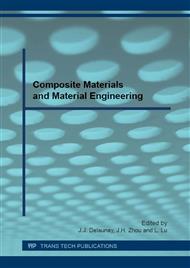p.73
p.81
p.85
p.92
p.97
p.101
p.105
p.111
p.117
Comparison between Tungsten and Bronze Powder as a Backing Material of Ultrasonic Probe for Residual Stress Measurement
Abstract:
This research is aimed to compare the influence of backing materials on characteristics of ultrasonic probe for residual stress measurement. A disk-shaped piezoelectric ceramic (PZT) acts as the active element to generate the ultrasonic wave. An optimization composition of backing material was investigated in order to produce suitable acoustic impedance which matches to the active element. In this study, the backing material has been successfully fabricated from tungsten powder combined with epoxy resin (T-ER) and bronze powder associated with epoxy resin (B-ER). The influences of metal powder content on sound velocity and acoustic impedance of the backing materials were measured by using Pulser/Receiver and displayed by an oscilloscope. Each ultrasonic probe was then implemented to measure residual stress obtained from static tension load below yield point. The results shown that the highest acoustic impedance of T-ER and B-ER was 14.7 106 and 7.2 106 kg/m2s, respectively. The fabricated ultrasonic probe using B-ER as a backing material exhibited lower noise and higher amplitude than ultrasonic probe using T-ER backing material.
Info:
Periodical:
Pages:
97-100
Citation:
Online since:
July 2016
Authors:
Price:
Сopyright:
© 2016 Trans Tech Publications Ltd. All Rights Reserved
Share:
Citation:


